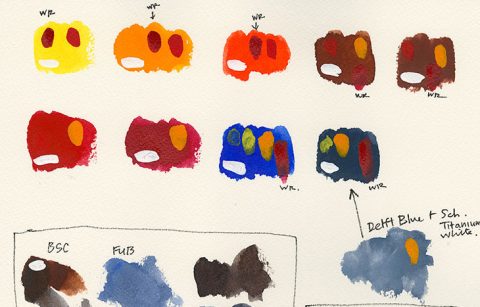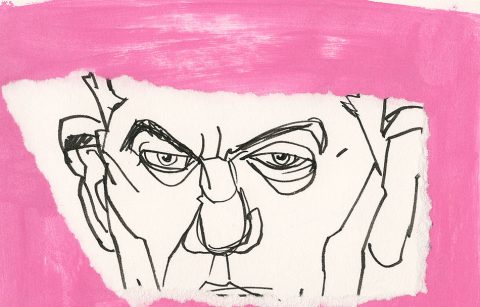Above, three different papers, three different journals. Left to right: the new Folio paper, pen and watercolor, Annigoni Designo with Pentel Color brush and gouache, and Fabriano Artistico hot press with pen, ink and gouache.
Two weeks ago about 20 visual journal keepers met to discuss PAPER at the MCBA Visual Journal Collective. As we went around the room sharing what we liked to do with paper and what we hoped a paper would do for us (support collage, take wet media, etc.) more than half admitted they were paper “addicts.” We knew we were in good company.
Some attendees admitted also that they loved any type of paper and were paper “magnets” always finding paper on their outings and returning home with scraps of this and that to use in their artwork. Only a couple members had made paper, but everyone agreed they loved to collect it and plan projects.
Group members were asked to share a little about what they looked for in a paper and what their favorite paper was. While one woman admitted to having a stash of the elusive and now discontinued Daniel Smith Drawing and Framing (the hands down best all-media paper ever), others remained loyal to Fabriano Artistico (perhaps because they were still using old stock, or because the changes didn’t matter to them—see my earlier note on Fabriano Artistico, surface tests on the new paper have shown disappointing results). Most of those present, however, were interested in finding more options for their book binding needs.
Where Can We Learn about Paper?
First you need to ask people whose work you like. Also you also need to research by reading catalogs (the old Daniel Smith Catalogs from 10 years ago when they were carrying just about every type of paper imaginable are fabulous reference books; even their current catalog provides great info on current offerings).
The best way to find out about paper, however, is to test it yourself. I have tested over 80 art papers for bookbinding and through that testing process I have found papers that work for certain structures and not others, work for certain media and not others. Of course there have also been discontinued papers (more than I care to remember; and I remember them each fondly). As a binder of your own journals you have to be on the look out for new or substitute (new to you) papers all the time.
It also helps to be clear with yourself on what type of work you want to do in your journal so that you pick appropriate papers.
I have a friend who loves Biblio. I find the paper too light weight and a bit soft for the type of work I like to do with the pens I use. So what works for one person isn’t going to work for another artist necessarily. As I wrote earlier you need to test it yourself.
Don’t Buy Pads
Several in the group talked about buying large sized pads of paper and then cutting the pad pages down for their journals. I encouraged them to avoid pads and buy sheets instead. In the long run buying full sheets is more economical. With pads you’ll be limited as to size of a final book page because odds are the grain direction of the padded paper will run with the long measurement and when folding with the grain you’ll get a very narrow page size (e.g. 9 x 12 inch page with the grain direction running with the 12 inches will yield a 4.5 inch wide page maximum). It leads to more trimming and more waste. To bust out of this pattern you really need a large sheet for folding and planning.
Another reason I don't like pads is that I’ve found padding tends to change the surface of a paper. Strathmore Aquarius II and Magnani’s Annigoni Designo are just two papers I’ve used where the padded paper is a totally different animal than the full sheet. Padding in these papers seems to make their surfaces harder and more compressed, smoother and less yielding. While I will buy, upon occasion, watercolor blocks and pads of Strathmore 500 Series Bristol, I won’t buy pads of anything I’m going to use for binding purposes.
If you do want to buy pads at least also buy a sheet and compare to see if you are missing out on a better version of that surface for your purpose.
What Do You Look for in a Paper for Visual Journaling?
Most people at the meeting were looking for a paper that would take mixed media. Other than that they were there to find new options. Some wanted papers that didn’t buckle when wet. Some only wanted hot press papers for their writing. Others wanted cold press papers so that their paintings would have texture. Still others needed thicker papers to stand up to heavy collage work. One woman shared with us that she used any “crappy paper” and then covered it with gesso. Another member professed a partiality to Chinese papers. And still another member brought a plain paper bag of no distinction and showed how it had been transformed with a Gaylord Schanilec print on it.
I shared my criteria with the group. I look for paper that folds well with the grain and doesn’t crack when folded with that grain. I want a paper that tears easily with a bone folder because I don’t cut my papers. I need a paper that is fairly opaque because I like to use some heavy duty black inks—and of course the Pentel Pocket Brush Pen. I also need a paper sized sufficiently to take watercolor: this sizing could be internal, external, or both. Ultimately the paper must be foldable so I can make signatures out of it and sew it into book form.
Sample Packs of Paper
When I am teaching colored pencil drawing or paper selection for bookbinding I have sample packs of paper made up. I like to include pieces that are of sufficient size that the students can do a reasonably sized drawing on the piece, but also have a bit extra to cut off as a test strip to use first. Taking full sheets and cutting them into quarters or into 1/6th of a sheet size usually does the trick. It also makes the packs affordable with everyone splitting the total cost but not having to buy full sheets of paper to which they may not warm up.
I recommend you get some friends together and have a paper testing party.
If you live in the middle of nowhere, or have no art friends living nearby, note that some vendors sell pre-made sample packets.
Years ago Daniel Smith had the most wonderful packets. The samples were small (about 2 x 6 inches) but plentiful in each packet. For very little outlay of money I quickly identified papers that were worth buying in full sheets. Sadly they don’t do this any more, but they do offer full sheet sample packets at a discount. They offer a printmaking sampler of 32 sheets for $79.95; a watercolor sampler of 16 sheets for $69.95; and a Japanese paper sampler of 16 sheets for $59.78. The Daniel Smith catalog lists the papers included in the sampler.
Locally, in St. Paul, Wet Paint carries a watercolor paper sampler. This packet consists of 14 partial sheets, but all pieces are a fair size and useful for real experiments and artwork. Price varies depending on the sheets contained, but I think it runs about $20.00 and is a good deal.
If you are interested in Chinese papers I noticed that Art Supply Warehouse has a Golden Panda Sample book of rice and silk papers. The 5 x 5 inch sample book has 11 sheets and costs only $1.99.
If you are aware of other venders that sell sample packets (not the digital sample packets which are available everywhere, but a variety of art papers) please let me know so we can post them!
Visit tomorrow for part two of this post. I'll give you some paper suggestions.























Hi, Roz….I enjoyed this entry in your blog (heck, I enjoy your blog!) and hope you’ll make some specific recommendations tomorrow about the paper that you like for visual journaling.–Carol C.
Roz, great post! Legion Paper in New York has some great sampler boxes of drawing papers, watercolor papers, printmaking papers, all KINDS of papers! Kate told me about this, I think. You and your readers really should check them out:
<http://www.legionpaper.com/Sample-Department.htm>
great recommendations! i’m bookmarking this post so i can come back to it for help when i buy my next round of paper. thanks as always for sharing your research and experience.
Thanks Laura, I thought Legion just had the digital sampler boxes but I asked at Wet Paint and found they have other paper samplers as well. Legion now supplies a lot of the papers that used to come through other channels or something (I don’t really even begin to understand all the consolidation that has happened).
All the papers they have in these samplers are papers I have tried and I think it is a nice way for people who don’t want to get full sheets to look at a paper. Thanks for the suggestion!
Roz
This was very helpful. I am always on the lookout for good paper. I am currently vacillating between hot and cold press.
Thanks. Your blog is always so informative!
Kim
Paper and Ink Arts and John Neal Books cater primarily to calligraphers but offer very good paper samplers (especially fantastic for people who draw in ink a lot).
Great post!
Oh, how I miss the old Daniel Smith sample packs. I found a sample pack of watercolor paper that I had forgotten about the other day.
Thanks for the tip about Legion Paper! I’ll have to check out their sample packs.
Kim, I’m glad you’re enjoying the blog.
So when you are looking for HP or CP are you looking for 90 or 140 lb. paper? My problem is that there aren’t a lot of 90 lb. watercolor papers readily available (and I like things to be close at hand and not mail order).
I was surprised that I really liked working with Winsor Newton 90 lb. hot press paper. (I buy almost none of their products so I had a mental “thing” about it.) But it’s a nice paper and may become my standard HP since I can actually get it locally. More tests to do.
Roz
Pica, thanks for the great tips on two more places to get paper samples.
Roz
Sydney, I still have my old Daniel Smith sample packs. Sadly many of the papers are no longer available, but I love having them as a record of a time.
Roz
Dannie from California had trouble with the posting and wrote to give the following leads on additional samplers. I didn’t deal with bookcloth samplers in my post (sticking with papers) but I was actually recommending to a friend the bookcloth samplers at Talas. Now she can have another source for that too. Thanks Dannie, Roz:
Hi Roz
I have sample packs from Hirami Paper in Santa Monica, Ca. They have several paper packs divided into specialty catagories. They also have a bookcloth pack. McClains printmaking supply in Oregon and Twin
Rocker also have sample packs. All are little swatches 2×3 about, some smaller if the paper is really expensive such as the various gompi papers from Hirami. They are good for testing though, I used most of mine to see which would take suminagashi. Dannie
Hi Roz,
You work on both sides of the sheet in your journals. Has this been an issue for you in the way the paper handles? Can you recommend papers that work well on both sides for the journals you make? Thanks for your informative blog.
Laraine
Laraine, if you look at today’s post (Wednesday) which is part two of this topic, you’ll find a number of papers that I use all the time in my journals.
Some have a difference between front and back of the sheet and you have to be careful to collate so that same surface (front or back of the sheet) faces same surface across the spread, but that’s simply a matter of paying attention when you tear your sheets down and folding them appropriately. For the most part that difference is slight. Many of my students don’t even notice a difference (part of it depends on how sensitive you are to nuances in paper) or are working in media that isn’t going to “show” a difference, for instance on some papers people working on pencil may have essentially the same experience on both sides of a sheet but someone watercoloring on that sheet might experience something different.
Artists really need to test a bunch of papers, front and back, with the same media to ascertain not only what the broad characteristics of the sheet are but also their sensitivity level.
Have you been using papers so far that you’ve had difficulty with? If so what papers and what was your particular difficulty? That might help me suggest a particular paper.
The only time I don’t work on both sides of a sheet are in books which are specifically for pencil (graphite and colored pencil) only. I don’t like working on the back of a sheet and having the pencil from the previous page pushed down into its opposite page. (I don’t put glassine or other barrier papers in between sheets as there would be too much loose paper falling out of the journal.)
It’s rare though, for me to keep a journal just for pencil like this, certainly has to be a special project journal and not my daily journal.
Otherwise I don’t have any problem with working both sides of the sheet on my favorite papers, many of which are listed in the part 2 post.
Roz
Hi Roz,
Most of my preferred papers were outlined in your second post. I use Fabriano Artistico; Arches Aquarelle; Stonehenge that was given to me in a bound book so I don’t know the specific sheet; I also have a number of printmaking papers collected over the years including Rives BFK and Hahnemuhle, much loved for etching. Among your many impressive traits, your ability to keep track of information about paper you own and use is terrific.
My sketchbook work is primarily done in Holbein Multi-drawing Books/OF. I like the smaller ones. The paper has an entirely different feel to it in larger sizes, a difference that I don’t like. Your conversation with Danny Gregory about how you make your own books inspired me to try to make my own. I bought the Webberley/Forsyth book recommended in a previous post.
Thank you for following up your post with a detailed answer to my question. I receive your blog through Feedblitz, so I’m often a day behind in reading what you’ve published.
Laraine
Laraine, thanks for posting what you like to use! I’m a chart maker and note taker so it is second nature to me to keep detailed notes on paper I use and how it performs. I have several charts for this purpose, some relating to art use and some relating to bookbinding, and one for tear diagrams (that one’s electronic!) One of the bookbinding charts is particularly useful because it tells me how many sheets I need for how many signatures, for a certain size, etc. and the spine size that will result, and board size, etc. so I can pre-cut my materials. (I never pre-cut my spines until I do some sewing, however, because on any given day my tension might be a bit different and make enough of a difference, but I have a ball park idea of how much board I’ll need so it’s at least on hand.)
It seems easier to make charts and spend 30 seconds recording something than reinventing the wheel each time I bind. I know this would drive other folks crazy, but it keeps me sane and happy. It also speeds up the process when I am making handouts for classes and need to have dimensions for something or need to create a supply list so I can cost everything out.
When I was a child I used those Holbein books you discuss. They were always readily available where we were living. I don’t like the spiral bindings though.
I’m so glad that you are embarking on a bookmaking adventure! You will have great fun. It is delicious to work in a book you’ve made yourself.
Roz
Really interesting and useful post Roz. Looking forward to seeing what comes next.